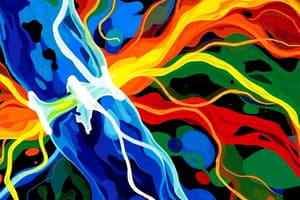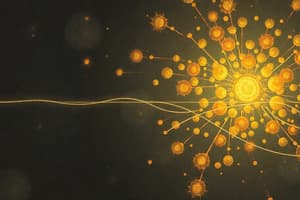Podcast
Questions and Answers
What is the primary difference between the concentration gradient and electric gradient acting on ions?
What is the primary difference between the concentration gradient and electric gradient acting on ions?
The concentration gradient moves ions from areas of high to low concentration, while the electric gradient involves the attraction of opposite charges and the repulsion of like charges.
Describe membrane potential in one sentence.
Describe membrane potential in one sentence.
Membrane potential is the voltage difference across the neuronal membrane at a given moment, indicating the electrical potential inside the cell compared to the outside.
Which ions are primarily involved in the action potential, and what role do they play?
Which ions are primarily involved in the action potential, and what role do they play?
Na+ ions primarily mediate the rising phase by moving into the cell, while K+ ions mediate the falling phase by moving out of the cell.
Explain the difference between channels and pumps in the context of ion transport.
Explain the difference between channels and pumps in the context of ion transport.
What is a concentration gradient, and how does it relate to ion movement?
What is a concentration gradient, and how does it relate to ion movement?
How does the movement of ions during an action potential affect a neuron's ability to transmit signals?
How does the movement of ions during an action potential affect a neuron's ability to transmit signals?
Identify the primary ions involved in resting potential and their locations relative to the cellular membrane.
Identify the primary ions involved in resting potential and their locations relative to the cellular membrane.
What occurs during the 'rising phase' of an action potential?
What occurs during the 'rising phase' of an action potential?
Flashcards are hidden until you start studying
Study Notes
Overview of Excitability
- Excitability is a key trait of neurons, enabling responses to environmental stimuli such as physical changes, chemical signals, or mechanical pressure. Upon detecting a stimulus, neurons experience depolarization, resulting in action potentials that facilitate information transmission in the nervous system. Ion movement is influenced by concentration gradients, which cause ions to diffuse from high to low areas, and electric gradients, which direct ions based on charge. These forces are vital for maintaining resting potential and rapid action potential propagation.
Membrane Potential
- Membrane potential is the voltage difference across a neuronal membrane at any given moment.
- It indicates the electrical potential inside the cell relative to the outside.
- More negative charges accumulate inside the cell, while positive charges are more concentrated outside.
Distribution of Ions
- Ions are not evenly distributed across the cell membrane:
- Potassium ions (K+) are more concentrated inside the cell.
- Sodium ions (Na+), calcium ions (Ca2+), and chloride ions (Cl-) are more concentrated outside the cell.
Ion Movement Across Membrane
- Ions cross the membrane through transmembrane proteins:
- Channels facilitate passive transport via diffusion, moving ions down their gradients.
- Pumps require energy for active transport, moving ions against their gradients.
Action Potential
- During an action potential, membrane proteins open to allow ions to cross.
- Sodium (Na+) and potassium (K+) ions play critical roles in changing membrane potential:
- The rising phase is mediated by the influx of sodium ions (Na+) into the cell.
- The falling phase is driven by the efflux of potassium ions (K+) out of the cell.
Synaptic Transmission
- Synaptic transmission involves communication between neurons via the release and reception of neurotransmitters.
Preparation for Class
- Key topics for further study include:
- Definition of ions and major types of biomolecules.
- Interaction of ions and biomolecules with water.
- Understanding of concentration gradients.
- Recommended readings from Bear, Connors, and Paradiso Chapter 3, pp. 57-9, 64-70, and review of Khan Academy videos.
- Complete Problem Set 2 as part of the preparation.
Studying That Suits You
Use AI to generate personalized quizzes and flashcards to suit your learning preferences.




